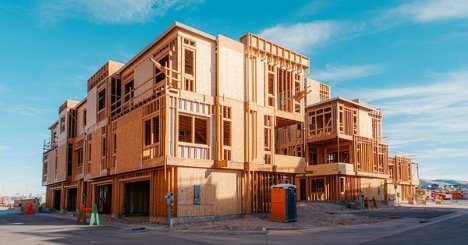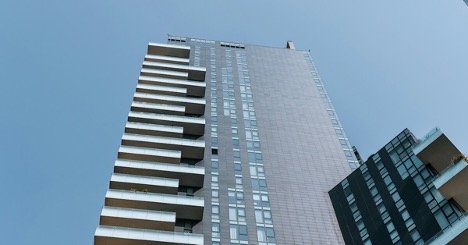
- calendar_month May 14, 2024
- folder Commercial Real Estate
The debt service coverage ratio (DSCR) is crucial because it measures a company's ability to generate enough cash flow to meet its debt obligations, including interest and principal payments (if applicable). A high DSCR indicates that the company has sufficient earnings to cover its debt, which reassures creditors and investors about the company's financial stability and risk management. Conversely, a low DSCR signals potential financial distress, suggesting that the company may struggle to meet its debt commitments, which could lead to higher borrowing costs, reduced access to credit, or even default. Therefore, maintaining a healthy DSCR is essential for sustaining financial health and securing favorable financing terms. The following article written by Shanti Ryle of Crexi, will dive deeper into the mechanics of DSCR, its role in various scenarios, and its advantages and disadvantages, equipping you with the knowledge you need to make more informed investment decisions.
Shanti Ryle | March 8, 2024
Commercial real estate (CRE) hinges on a variety of financial metrics. Among these, the DSCR is a critical tool for investors and lenders alike. It's a financial barometer gauging the health of an investment and its ability to cover debt obligations.
For CRE investors, understanding DSCR can mean the difference between securing favorable loan terms or facing financial roadblocks. This ratio, calculated by dividing Net Operating Income (NOI) by Total Debt Service, reveals an investment's potential profitability and viability.
Understanding debt-service-coverage-ratio is not just about crunching numbers. With a solid understanding of the formula, commercial real estate investors are better equipped to navigate financial decision-making, assess risk accurately, and, ultimately, steer their investments toward greater profitability.
In this article, we will dive deeper into the mechanics of DSCR, its role in various scenarios, and its advantages and disadvantages, equipping you with the knowledge you need to make more informed investment decisions.

What Is Debt-Service-Coverage-Ratio?
Debt-Service Coverage Ratio (DSCR) functions as a risk assessment tool. It highlights the financial strength of an investment by evaluating its ability to cover debt obligations solely from its operating income.
In other words, DSCR quantifies an investor's cushion between the property's earnings and debt commitments. This ratio serves as a litmus test for lenders during loan approval and provides investors with insights into the sustainability of their investments.
DSCR Formula
The following formula is used to calculate debt-service-coverage-ratio:
DSCR = Net Operating Income / Total Debt Service
Let's break down each component of this formula:
- Net Operating Income (NOI): This is the total income generated by a property after deducting all operating expenses. Operating expenses include marketing expenses, maintenance costs, management fees, leasing commissions, tenant improvements (TIs), and insurance but do not include debt payments, income taxes, or depreciation. The NOI gives investors a clear picture of the property's profit potential.
- Total Debt Service: This is the total amount of current debt obligation, including both principal and interest payments on all loans for the property. It represents the financial responsibility that the investor has towards lenders.
A DSCR greater than 1 indicates that the property generates enough net income to pay its debt obligations. Conversely, a DSCR less than 1 suggests that the NOI is insufficient.

How To Calculate DSCR
Here's a step-by-step guide on how to calculate the debt-service-coverage ratio. For this example, we'll assume a property is purchased for $1.5 million with a down payment of 30%, and the NOI is $90,000 per year:
Identify the Net Operating Income (NOI)
The NOI is the annual revenue from the property minus all operating expenses. In our example, the NOI is given as $90,000 per year.
Determine the Total Debt Service
This is the sum of all property debt obligations, including principal and interest payments.
To compute this, you first need to calculate the loan amount. If the property is valued at $1.5 million and the down payment is 30%, the loan covers the remaining 70%. The loan amount would therefore be $1.5 million * 0.7 = $1.05 million.
Assuming a mortgage term of 30 years and an interest rate of 5% applied to the loan amount, you can use an online mortgage calculator to figure out the annual total debt service (both principal and interest). For our example, this comes out to approximately $67,597.
Calculate the DSCR
Now, divide the NOI by the Total Debt Service to get the answer. For our example, this would be $90,000 / $67,597 = 1.33.
This DSCR value indicates that the property's income is 1.33 times higher than its debt obligations. A DSCR greater than 1 typically signifies a positive cash flow and a potentially sound investment.
Remember, this is a simplistic example, and real-world calculations may involve more complex scenarios and additional factors.
When Is Debt-Service-Coverage-Ratio Used?
Now, let's explore how DSCR comes into play in new financing and refinancing scenarios.
New Financing
When buying new properties, investors often seek financing to cover a substantial part of the purchase price. Here, lenders use the DSCR as a risk assessment tool:
- Loan Approval: Lenders look for a DSCR greater than 1, indicating that the property's net operating income can comfortably cover the loan repayments. A higher DSCR increases an investor's chances of securing a loan.
- Interest Rates & Terms: Besides affecting loan approval, DSCR can also influence the loan terms. A higher NOI or consistent cash flow might result in more favorable terms, such as a lower interest rate or a smaller down payment requirement, thereby reducing the loan cost.
- Loan Amount: Lenders may also use DSCR to determine the maximum loan amount. They calculate the loan amount to align the DSCR with their risk threshold. A property with a high NOI could potentially secure a larger loan.
Refinancing
Refinancing replaces an existing loan with a new one, usually to benefit from lower interest rates or better loan terms. The DSCR plays a vital role in this process:
- Refinancing Approval: Like new financing, lenders will reassess the DSCR during refinancing. An improved DSCR—perhaps due to increased rental income or decreased expenses—can improve the chances of loan approval.
- Negotiating Power: A higher DSCR when refinancing can give the borrower more negotiating power. They could potentially secure a lower interest rate, extend the loan term, or even cash out some of the property's equity.
- Prepayment Penalties: Some loans have prepayment penalties if the loan is paid off before the end of its term. If the DSCR has improved significantly, the savings from refinancing could outweigh these penalties, making it financially viable to refinance.

Advantages of DSCR
- Financial Health Indicator: DSCR provides a clear snapshot of a property's ability to generate enough income to cover its debt obligations. A high DSCR indicates that the property is generating sufficient income relative to its debt, signaling a healthy investment.
- Risk Assessment Tool: Lenders heavily rely on DSCR when assessing the risk of granting a loan. A higher DSCR can reassure lenders of an investor's ability to repay the loan, thereby increasing the chances of loan approval.
- Negotiation Leverage: A strong DSCR can give investors leverage during loan negotiations. It can potentially secure more favorable loan terms, such as lower interest rates or relaxed down payment requirements.
- Future Planning: DSCR can help investors anticipate future financial performance. By tracking changes in DSCR over time, investors can identify trends and make informed decisions about property management, pricing, and even potential sale timing.
Disadvantages of DSCR
- Single Metric Limitation: While DSCR is a valuable tool, it should not be used in isolation. It does not account for other important factors such as property condition, market conditions, or potential future capital expenditures. Investors should consider these aspects alongside DSCR for a comprehensive evaluation.
- Vulnerable to Market Conditions: DSCR is based on the Net Operating Income (NOI), which can fluctuate with market conditions. Changes in occupancy rates, rental prices, or operating expenses can significantly impact the NOI and, consequently, the DSCR.
- Not a Profit Indicator: DSCR measures the ability to cover debt service, not profitability. A property may have a high DSCR but low profitability due to high operating costs, low rental income, or other factors.
- Misleading in Case of Variable Rate Loans: For properties with variable rate loans, the DSCR can be misleading. As interest rates fluctuate, so too will the debt service, potentially affecting the DSCR and the perceived financial health of the property.

Other Important Metrics To Consider
The Debt-Service Coverage Ratio is a fundamental tool in evaluating property investment. However, would-be buyers should not use it in isolation. A comprehensive assessment requires considering other financial metrics that provide additional insights into the property's performance and potential risks.
Loan-to-Value Ratio (LTV)
While DSCR focuses on income generation, loan-to-value ratio (LTV) looks at the appraised value of the underlying asset. A higher LTV means the lender is financing a larger portion of the property, which typically presents a higher risk.
For instance, a property might have a high DSCR indicating strong income, but if it also has a high LTV, it signals that the borrower has smaller equity in the property, potentially increasing the lender's risk. If the borrower defaults and the property goes into foreclosure, the lender may not recover the total loan amount when selling the property, especially if property values have decreased.
Cash-on-Cash Return
Cash-on-cash return measures the investment's annual return after paying all operating expenses and debt service during the same period. While DSCR ensures that the property generates enough income to cover debt service, cash-on-cash return goes further to determine how much of that income turns into actual cash flow for the investor.
This means it accounts for the actual returns an investor can expect to see in their pocket after all expenses and debts are paid. Considering both DSCR and cash-on-cash return gives a more complete picture of the property's financial health and the tangible returns the investor can expect.
Capitalization Rate (Cap Rate)
The capitalization rate, or cap rate, is a metric that provides a snapshot of a property's potential return on investment, independent of financing. It's calculated by dividing the Net Operating Income (NOI) by the property's market value.
Cap rate complements DSCR by providing an idea of the return on investment if the property were purchased outright without any financing. A high cap rate combined with a strong DSCR can indicate a potentially profitable investment.

The Bottom Line: Take Your CRE Investment Strategy to the Next Level
Debt Service Coverage Ratio (DSCR) offers investors a unique perspective on a property's financial health and capacity to meet debt obligations. This understanding can pave the way for securing more favorable loan terms and making more informed investment decisions.
However, the DSCR is not an isolated tool - it's part of a broader arsenal of financial analysis instruments. To form a comprehensive assessment, it should be coupled with other metrics, such as net operating income, capitalization rates, and cash-on-cash returns.
This holistic approach allows investors to mitigate potential risks, seize profitable opportunities, and navigate the commercial real estate market confidently and precisely.
Working with a Realtor is vital when investing in commercial real estate because we bring specialized knowledge, market insights, and negotiation skills that can significantly impact the success of your investment. A seasoned CRE Realtor can help you navigate the complexities of commercial property transactions, ensuring you understand all financial aspects, such as cash flow projections, cap rates, and the debt service coverage ratio. I will provide thorough financial analyses and due diligence, identifying potential risks and opportunities that you might overlook. This expertise enables you to make well-informed decisions, optimize your investment strategy, and ultimately maximize your returns while minimizing risks.
